|
|
|
Sort Order |
|
|
|
Items / Page
|
|
|
|
|
|
|
| Srl | Item |
| 1 |
ID:
128151
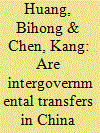

|
|
|
|
|
| Publication |
2012.
|
| Summary/Abstract |
Since 1994, China's central government has implemented a sequence of fiscal recentralization measures to increase its equalization capacity and reduce regional income disparities. However, the effect of intergovernmental transfers on equalization has been called into question by anecdotal evidence that seems to suggest that transfers from the center are not rule-based and are subject to heavy rent-seeking. Unlike past studies, which have focused on the equalization effects of total fiscal transfers from the center, this paper includes an examination of the equalization effects of different types of transfers because some transfers, which are inherently anti-equalizing, may mask the equalization effects of other types of transfers when they are lumped together to find the "average" effect. Using inequality measures, a decomposition of fiscal disparities, and dynamic panel data models, we find that China's intergovernmental transfer system that was established in 1994 does have some equalizing elements. To a large extent, these elements exist due to the mechanism designed to shrink the tax rebates that bear the legacy of the pre-1994 system; to a small extent, these elements exist due to the rule-based general-purpose transfer whose share in total transfers remains small but has increased since 2002. However, the equalization effects of the largest component of transfers, specific-purpose transfers, are anti-equalizing. They are typically not rule-based and thus subject to political influence. As a result, total transfers also exhibit significant anti-equalization effects.
|
|
|
|
|
|
|
|
|
|
|
|
|
|
|
|
| 2 |
ID:
128166
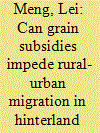

|
|
|
|
|
| Publication |
2012.
|
| Summary/Abstract |
In this paper I examine if China's grain subsidy program keeps farmers from engaging in migratory work using self-collected panel rural household survey data from Zhijiang, Hubei province. Making use of Zhijiang's unique geographical features, I construct a treatment and a control group and use a difference-in-differences methodology to identify the subsidy effect on migration. My results suggest that the grain subsidy policy does keep farmers at the rural origin.
|
|
|
|
|
|
|
|
|
|
|
|
|
|
|
|
| 3 |
ID:
128159


|
|
|
|
|
| Publication |
2012.
|
| Summary/Abstract |
There is increasing awareness that university-industry collaboration provides an important knowledge transfer channel and, thus, is a powerful driver of innovation. Universities are increasingly being asked to play incisive roles in the process of regional economic development. This paper assesses the extent to which university-industry collaboration, expressed in terms of private funding for university consulting research activities, is affected by the geographic proximity of an academic institution to an Industrial District (ID). Although the economic literature insists on the positive effects of proximity for these collaborations, empirical work on Italian ID so far shows no particular effects. This paper provides new insights into the effects of academic proximity to ID on university-industry collaboration, by presenting robust evidence that proximity to districts promotes the establishment of collaboration agreements. This sheds new light on the need for targeted policies to support local productive systems. The empirical evidence is based on an analysis of qualitative information and an econometric analysis of financial data for the whole population of Italian university departments engaged in research in the Engineering and Physical Sciences.
|
|
|
|
|
|
|
|
|
|
|
|
|
|
|
|
| 4 |
ID:
124542
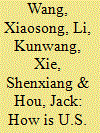

|
|
|
|
|
| Publication |
2013.
|
| Summary/Abstract |
Utilizing a political economy approach towards trade policy formulation, we examine the case of how the U.S. House voted on the PNTR status for China. Our focus is to analyze the factors affecting the legislators' voting behavior and to deduce the rationale behind these factors. We find that the U.S. trade policies towards China represent a balanced equilibrium based on interactions between the government and special interest groups. The individual characteristics of the legislators were not important in the process. Predictions of neo-classical trade models regarding the attitudes of various groups on trade liberalization could not be fully validated in the voting outcome of the PNTR bill.
|
|
|
|
|
|
|
|
|
|
|
|
|
|
|
|
| 5 |
ID:
128157


|
|
|
|
|
| Publication |
2013.
|
| Summary/Abstract |
The paper offers an updated picture of the policies implemented by the government of the Guangdong Province (China) to foster the industrial development and the technological upgrading of its territories. Among these policies is the promotion and the institutional acknowledgement of a growing number of industrial clusters, defined as "Specialised Towns", characterized by a high spatial concentration of firms producing one specific item (or a limited range of similar products). In the view of the provincial and local governments these types of industrial development programs are used to increase firm agglomerations, spatial concentration and visibility, which in turn leads to increased specialisation, industrial output, innovation and economic growth. However, little specific empirical evidence has been collected to support this view and the debate, at the national and international level, on the effectiveness of such interventions seems to be still largely ideological. The paper offers a contribution in this sense by offering a detailed description of the policy tools, by suggesting synthetic indexes to quantify policy efforts and industrial performances in Guangdong territories and by providing a first statistical analysis of these indexes.
|
|
|
|
|
|
|
|
|
|
|
|
|
|
|
|
| 6 |
ID:
128165


|
|
|
|
|
| Publication |
2012.
|
| Summary/Abstract |
The ongoing private capital inflows from Taiwan to China is a steady concern for Taiwan's policymakers. According to the official data, Taiwan's private enterprises have cumulatively invested about US$ 150-280 billion in China since 1987. However, the figures are widely perceived to be an underestimation and there exists a huge gap even between the estimations conducted by different government departments. The purpose of this paper is to re-estimate Taiwan's net foreign assets (NFA) against China, revising the so-called "dark matter" hypothesis proposed by Hausman and Sturzenegger (2006, 2007). In contrast to the current statistics being limited to registered direct investment or census investigation, the advantage of our model is that direct investment, portfolio investment, and the possible knowledge and property spillovers are included. We show that changes in Taiwan's NFA against China over GDP are negative in economic and political turmoil, such as the missile crisis in 1995, Asian financial crises in 1997-98, and global tsunami in 2007-09. From 2000, the growth rates we simulate are never lower than the official data till 2009. We also suggest some possible economic causes that lead to the huge Taiwan's NFA against China.
|
|
|
|
|
|
|
|
|
|
|
|
|
|
|
|
| 7 |
ID:
128162
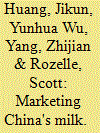

|
|
|
|
|
| Publication |
2012.
|
| Summary/Abstract |
Small farmer participation in marketing chains in emerging commodity markets and the determinants of their marketing channel choices are the center of many recent empirical and theoretical papers in the literature. The dairy sector is emerging in China. There are many fundamental questions about how farmers make dairy marketing decisions in China at the farm gate level that are unanswered. This makes the dairy sector in China a good place to study farmers in emerging marketing chains. Based on three sets of unique data collected in the mid-2000s in Greater Beijing, the analyses show that small farmers were the major producers of milk. There is no evidence that small farmers are being excluded from emerging marketing channels. One of the differences of China's dairy sector in the mid-2000s is that its marketing chain itself had many different types of agents that procure milk - and few of them were large; most were individual entrepreneurs. The high level of the competiveness may be the reason that individual agents do not have monopoly power and why small farmers can operate in the system.
|
|
|
|
|
|
|
|
|
|
|
|
|
|
|
|
| 8 |
ID:
128161
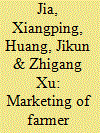

|
|
|
|
|
| Publication |
2012.
|
| Summary/Abstract |
The upstream agrofood market in China is dominated by a vast number of small farmers and traders, which challenges food safety compliance. To promote small farmers' access to the commercialized agrofood market, membership in farmer professional economic cooperatives (FPCs) is considered to be an important strategy by the Chinese leaders. The goals of this study are to investigate the marketing of FPCs in China and to determine their record of food safety compliance. Based on 157 FPCs from a nearly national representative survey, this paper shows that marketing FPCs in China relies primarily on the wholesale market, but there is a notable penetration of the modern supply chain via FPCs. Government-driven agribusiness facilitates farmers' access to markets via FPCs. However, food safety standards are not well-specified in the current FPCs' marketing.
|
|
|
|
|
|
|
|
|
|
|
|
|
|
|
|
| 9 |
ID:
128150
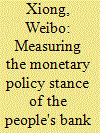

|
|
|
|
|
| Publication |
2012.
|
| Summary/Abstract |
The People's Bank of China (PBC) has employed a range of different instruments in the implementation of its monetary policy over the past decades, so perhaps no single instrument would constitute an adequate representation of the monetary policy stance. We thus develop a new policy stance index, and examine it in an ordered probit model, which follows the studies by Gerlach (2004) and He and Pauwels (2008). The empirical results show that in a backward-looking model, monetary policy reacts to actual output growth; one the other hand, when deviations from trend levels are considered, the PBC concerns inflation most seriously. In a forward-looking model, when we examine the PBC's statements in its quarterly Monetary Policy Executive Report from 2001Q1 to 2010Q3, it seems that the PBC's assessment of the prospects for inflation plays a key role determining the PBC's monetary policy stance. Our conclusions suggest that the PBC is informally targeting inflation, although no explicit target has ever been announced to the public by the PBC.
|
|
|
|
|
|
|
|
|
|
|
|
|
|
|
|
| 10 |
ID:
128156
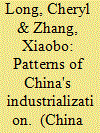

|
|
|
|
|
| Publication |
2012.
|
| Summary/Abstract |
This paper presents a few stylized facts on the patterns of China's industrialization by computing a set of multi-dimensional measures on industrial concentration, regional specialization, and clustering based on census data at the firm level in 1995 and 2004. Our results show that China's rapid industrialization is characterized by the following patterns: industries have become more spatially concentrated; regions have become increasingly specialized; and firms have become more interconnected, both within industries and within regions. In addition, the number of firms is growing faster in clustered areas than non-clustered ones. Together these patterns suggest that China's industrialization process is largely cluster-based-a phenomenon in which a large number of highly interconnected firms are located within a well-defined geographic region.
|
|
|
|
|
|
|
|
|
|
|
|
|
|
|
|
| 11 |
ID:
128149


|
|
|
|
|
| Publication |
2012.
|
| Summary/Abstract |
The purpose of this essay has not been to provide China with a detailed list of all of the things that the country must do to maintain a high growth rate. The purpose of this essay instead has been to analyze some of the most basic choices that China must make going forward, choices that are not yet fully understood either by government or private analysts. China has a very unusual economic structure at least on the aggregate demand side and that creates special challenges that other countries have not had to face to the same degree. How well China handles these challenges will determine whether it will continue to progress rapidly to middle income status and beyond.
|
|
|
|
|
|
|
|
|
|
|
|
|
|
|
|
| 12 |
ID:
128152
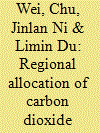

|
|
|
|
|
| Publication |
2012.
|
| Summary/Abstract |
This paper aims to identify which provinces will be allocated more (less) of a carbon dioxide reduction burden within China's pledge to reduce its carbon intensity at the Copenhagen conference. Using an extended Slacks-Based Measure (SBM) model incorporating an undesirable output, the CO2 reduction potential and marginal abatement costs are estimated for 29 provinces over the period 1995-2007. The CO2 Abatement Capacity Index (ACI) is constructed based on weighted equity and efficiency indexes. We find that there exists a large gap in potential reduction capability and marginal abatement cost among the eastern, middle and western regions. The eastern region has the least inefficient emission and the highest marginal abatement cost, while the western region has the largest potential reduction capability and the lowest marginal cost faced in reducing CO2 emissions. The difference in potential CO2 abatement among the provinces results from different industry structures, energy compositions and degrees of the openness of trade. The ACI ranking and the final allocation among provinces depend on the policy-makers' preferences regarding equity and efficiency.
|
|
|
|
|
|
|
|
|
|
|
|
|
|
|
|
| 13 |
ID:
128164


|
|
|
|
|
| Publication |
2012.
|
| Summary/Abstract |
This paper revisits the resource curse phenomenon in China and differs from the previous studies in four respects: (i) City-level data is used; (ii) A spatial variable is constructed to estimate the diffusion effect of natural resources among cities in the same province; (iii) The impact of resource abundance on economic development is investigated not only at the city level but also at the prefectural level in China; (iv) We use a functional coefficient regression model to deal with city-specific heterogeneity and, at the same time, analyze the transmission mechanism of the resource curse phenomenon. Our empirical results show that there is no significant evidence to support the existence of a resource curse phenomenon in China. On the other hand, we find that the degree of natural resource abundance in a city has a positive diffusion effect on the economic growth of neighboring cities within the same province at the city level, but not at prefectural levels. We attribute this to the urban bias policy.
|
|
|
|
|
|
|
|
|
|
|
|
|
|
|
|
| 14 |
ID:
128148
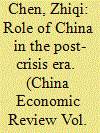

|
|
|
| 15 |
ID:
128155


|
|
|
| 16 |
ID:
128154
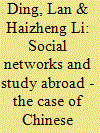

|
|
|
|
|
| Publication |
2012.
|
| Summary/Abstract |
Using a unique data set on Chinese visiting students in the US, we investigate some non-traditional determinants, especially social networks/connections, on the number of Chinese students hosted in American universities. Applying truncated, OLS, and GLS estimation, we find that social networks/connections have a strong positive and significant effect, and the result is robust across model specifications and estimation methods.
|
|
|
|
|
|
|
|
|
|
|
|
|
|
|
|
| 17 |
ID:
128158


|
|
|
|
|
| Publication |
2012.
|
| Summary/Abstract |
Local specialized markets and industrial clusters have been a driving force in China's transition from a rural to a market economy, as they have constituted a means for small local producers to access markets since the reform and the launching of the "open door" policies. In this article the industrial development of local industrial clusters endowed with specialized markets is outlined on the basis of fieldwork case studies in Zhejiang Province. In this area of China, tight linkages between the development of industrial clusters and specialized markets are based on social and economic foundations that have propelled the growth of market relations since the late 1970s. Together with local traditions and skills in both handcraft production and commerce, specialized markets accompanied the take-off of industrial clusters following the so-called "Zhejiang model" of development. The role of specialized markets is still crucial nowadays as a powerful channel for the distribution of consumer goods as well as a means of coordination of fragmented productions in China and abroad.
|
|
|
|
|
|
|
|
|
|
|
|
|
|
|
|
| 18 |
ID:
128163


|
|
|
|
|
| Publication |
2012.
|
| Summary/Abstract |
This paper examines differences in the spatial and temporal variations of rice yields in China and Brazil. Our analysis indicates that, in China, rice yields have converged over time and rice production has become increasingly homogeneous. In contrast, rice yields in Brazil have diverged over time, primarily due to variations in upland rice yields. Three hypothetical explanations may account for the different behaviors of rice yields in Brazil and China, namely: 1) differences in production systems (i.e. irrigated in China vs. upland in Brazil); 2) changes in rainfall patterns; and 3) bias in agricultural research and development (R&D) towards irrigated rice. Our empirical analysis supports the first two hypotheses by establishing that: 1) upland rice shows much more variation in yields compared to irrigated rice; and 2) changing rainfall patterns have primarily affected upland rice. We also provide evidence of the bias towards irrigated systems by looking at the patterns of varietal release.
|
|
|
|
|
|
|
|
|
|
|
|
|
|
|
|
| 19 |
ID:
128153


|
|
|
|
|
| Publication |
2012.
|
| Summary/Abstract |
Is China's demand for resources driven predominantly by domestic factors or by global demand for its exports? The answer to this question is of interest given the highly resource-intensive nature of China's growth, and is important for many resource-exporting countries, such as Australia, Brazil, Canada and India. This paper provides evidence that China's (mainly manufacturing) exports have been a significant driver of its demand for resource commodities over recent decades. First, it employs input-output tables to demonstrate that, historically, manufacturing has been at least as important as construction as a driver of China's demand for resource-intensive metal products. Second, it shows that global trade in non-oil resource commodities can be described by the gravity model of trade. Using this model it is found that, controlling for other determinants of resource trade, exports (and the manufacturing sector more generally) are a sizeable and significant determinant of a country's resource imports, and that this has been true for China as well as for other countries.
|
|
|
|
|
|
|
|
|
|
|
|
|
|
|
|
| 20 |
ID:
128160


|
|
|
|
|
| Publication |
2012.
|
| Summary/Abstract |
This paper analyzes the potential impacts of the agreements of Special Products and Sensitive Products (SPs) in Doha negotiations on world and China's Agriculture. By linking a global trade model to a national policy model which itself is connected to a set of disaggregated household data, we are able to assess the effects of the inclusion of SPs into a Doha agreement on agriculture in China and the rest of the world and different farmers across China. Our results show that since the inclusion of SPs in a Doha agreement adds more protection in agriculture, the total quantity of resources used in world agriculture increases. Although increasing, it is important to note that the total rise is only a fraction of a percent of agricultural value added and the gains to rural income per capita are likewise small. Moreover, an important difference between the apparent benefits of SPs is highlighted when they are considered for one country alone and when they are made available to all WTO members. The benefits to agriculture in China (and other countries) from increases in protection resulting from SPs are typically offset when these flexibilities are made available to all countries. While there are some positive benefits for certain vulnerable groups in society (in China), we show that there are adverse effects on equity and the impacts differ largely among regions.
|
|
|
|
|
|
|
|
|
|
|
|
|
|
|
|
|
|
|
|
|